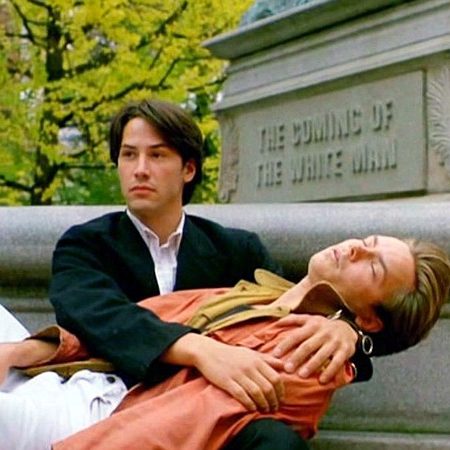Warm, literate, and unexpectedly puckish, Jonathan Richman looks like a youngish older man or an aging younger one. In the late sixties he got the best education in rock guitar playing a fan could’ve had: he went to every Velvet Underground concert he could. “These people would understand me!” he says in a gosh-darn tone inseparable from the singer-songwriter of “I’m Straight,” “Old World,” and “I Was Dancing in the Lesbian Bar.” Picking up an acoustic guitar, he provides a fifteen-second lesson on what the Velvets unique: Lou Reed’s devotion to a couple rhythm chords, John Cale’s subterranean drones, Maureen “Moe” Tucker’s minimalist but ostentatious banging, Sterling Morrison’s pinched leads. Like Bill Clinton at the 2012 Democratic National Convention, he explains complexity with ease. Maybe Jonathan Richman can explain Animal Collective to me.
Richman’s testimony is among the best reasons to watch The Velvet Underground, Todd Haynes’ documentary about the epochal New York band forged as a post-structuralist dream: Reed’s love of girl groups, doo wop, and Motown; Cale’s classical chops and apprenticeship with avant-gardist La Monte Young; and the polymorphously erotic after hours demimonde of Andy Warhol’s Factory scene. Another: the presentation of marvelous songs shaken free of cobwebs and dust. To listen to “Venus in Furs” and “Sister Ray” and “Rock ‘n’ Roll” in this context reminded me of the dawn of YouTube fifteen years ago: dear readers, for many of us watching our favorite acts giving long-lost interviews was often when we learned what they sounded like as people.
Presenting the first part of the Velvets’ story as split-screen tableaux, Haynes achieves a novel kind of sensuous narrative filmmaking. To watch Lou’s startlingly unblemished, even trusting youthful face in unbroken takes on the left side of the screen while an interviewee does the conventional talking head thing on the right, held together by that carouselambra of white noise and crunchy licks, is to understand how synesthesia works. The strategy works especially well when Haynes calls upon Cale to explain, with his heavy-lidded intensity and fabulous hair, the lessons in “natural harmonics” learned from Young; those sustained chords have the hypnotic weird rightness of humpback whale calls.
But The Velvet Underground unfurls as a straighter narrative than audiences would’ve expected from the director of Superstar (1988), Velvet Goldmine (1998), and I’m Not There (2007). I found the film a lot like the last Velvets album Loaded: studded with marvels, a confident retreat anyway. I found it a heteronormative narrative too. Reed’s bisexuality gets a nominal mention before Haynes hurries it offscreen. His sister Merrill, a formidable onscreen presence, still sounds conflicted about what happens after the collision of Reed’s aesthetic wanderlust, mental health problems, and experimental sexuality with the unthinking confusion of parents in 1960s suburbia. It would’ve been cool to have heard from younger Velvets fans who have reckoned with Reed’s empathetic “Says” songs like “Candy Says” and “Stephanie Says” — portraits of dysphoria and self-loathing, respectively. This is not to argue for judging the Velvets’ material by our values; rather, the treating of a discography as undulant as theirs into a Host adored without question from a monstrance violates the dialectical underpinnings of Haynes’ structure. “Let us do what you fear most,” Reed exhorted on “Some Kinda Love,” advice unheeded by the director.
Even Haynes dispenses with the split-screen approach in the last half hour, as if it were time to take each speaker’s valuations at their word. Band members and adjuncts disappear. Nico, about whom Jackson Browne (candid, unpatronizing) earlier commented, “Nobody compared people to her,” simply dissolves after Cale discusses his work on her solo debut Chelsea Girl. Cale’s replacement Doug Yule is a bigger problem. An essential collaborator after Cale’s ignominious termination, his contributions on bass, piano, and occasional lead guitar fueled late period rave-ups like “Foggy Notion,” “We’re Gonna Have a Real Good Time Together,” and “What Goes On,” the latter a plot of eternally fertile ground from which sprung, among others, The Modern Lovers, the Feelies, and Parquet Courts. Nobody really gives him his due. Frustrated by the endless touring (during which they recorded often ecstatic music), the Velvets didn’t break up so much as disintegrate, with Reed moving back in with his parents, Morrison returning to finish graduate work, and Tucker to a long stint at Walmart (a stint she’d vilify on 1989’s “Spam Again”). The band minus Yule reunited for a European tour that generated hope-filled headlines in the music press, especially coming after Reed’s late eighties commercial success. Reed didn’t bullshit: the Velvets broke up again, he said, because he insisted on producing and writing everything. A footnote, perhaps, in the band’s story, but a necessary complement after the largely uncritical depiction of their leader.
“This love and peace stuff was a load of crap,” Moe Tucker snarls. The standard line. She’s wrong. The formal experiments and commensurate fluidity in Reed lyrics like “Some Kinda Love” cohere into the realization of the so-called ’60s dream. The narcissism of, say, the CSNY set doesn’t mitigate the allure of love and peace. What are “Sunday Morning,” “Head Held High,” and “Jesus” but sketches of lives in the middle of becoming? To achieve a becoming is to find peace. To write about characters whose lives were saved by rock ‘n’ roll as men and women with unresolved sexual conflicts whose own lives were saved by rock ‘n’ roll remains the Velvets’ lasting contribution. But fuck “Teach Your Children” anyway — “European Son” and “What Goes On” taught the few children who heard them lessons in survival. Its compromises noted, The Velvet Underground exists because queer director Haynes understands the quartet as well as anyone. Dealing with a legacy is the provenance of criticism.
GRADE: B+


oh, they were the best